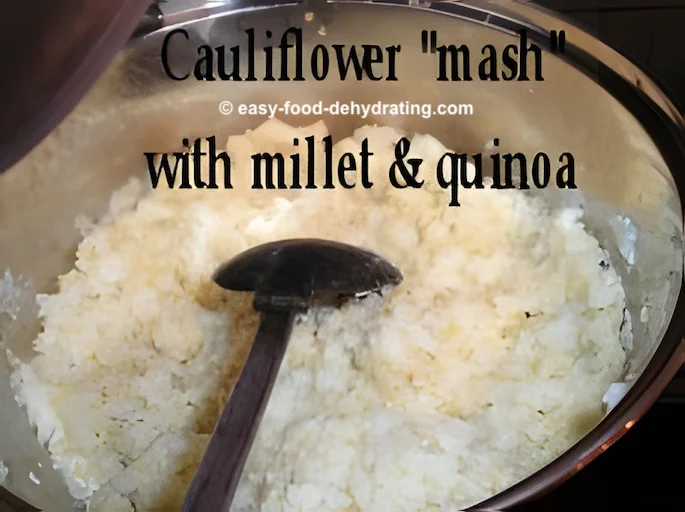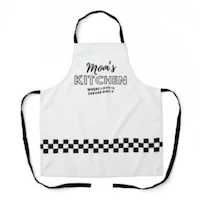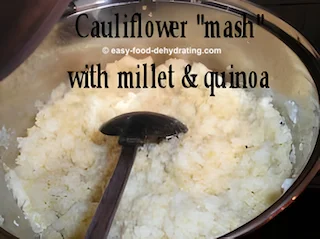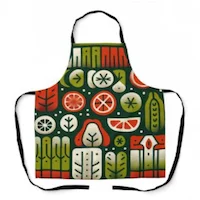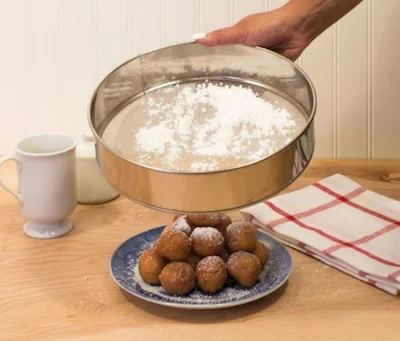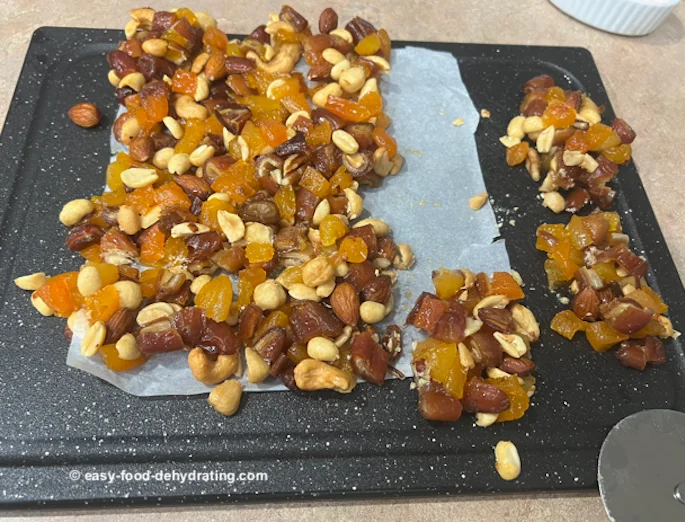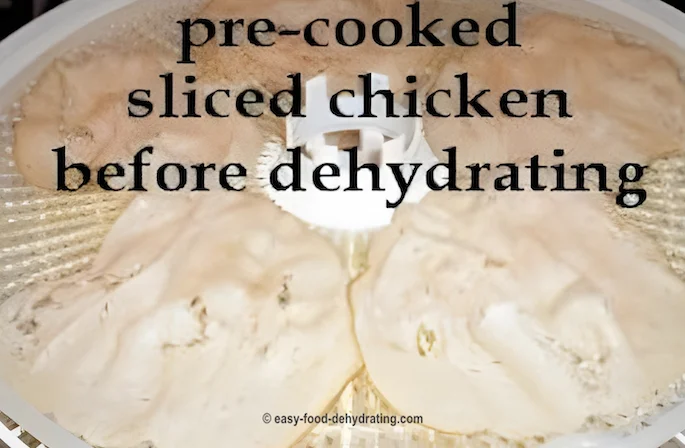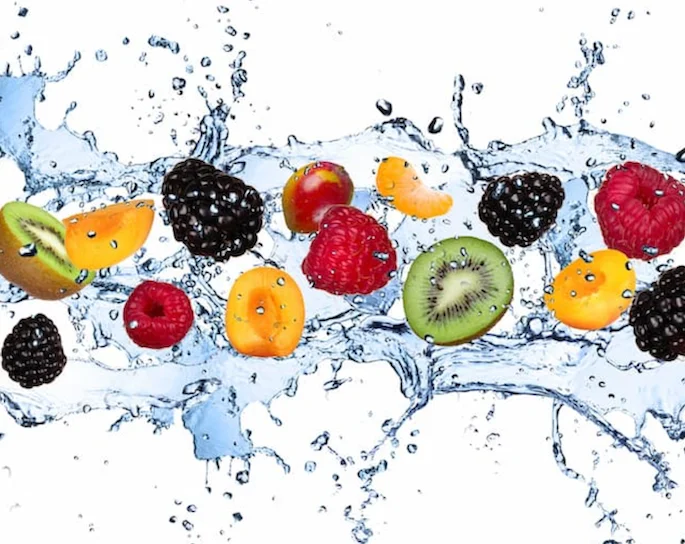whatever the reason or season!
- Home
- Easy Dehydrated Food Recipes
- Cauliflower Mash: Satisfying and Tasty
Cauliflower Mash
Make this cauliflower mash if your kids won't eat cauliflower! They will think they are eating real mashed potatoes!
It has a similar consistency to real mashed potatoes, and it doesn't differ much in taste either.
Go on, make it today... the kids will never know... it'll be our little secret...
Mother's Day Specials!
Ingredients for Cauliflower Mash
With Millet and Quinoa
As noted below, please remember to rinse your millet and quinoa before adding it to the mix (especially the quinoa because it has a really bitter taste if you don't rinse it first).
- 2 cups dehydrated cauliflower
- 1/4 cup dehydrated onion
- 2 slices dehydrated elephant garlic
- 2 cups boiling water (for dehydrated items) 1/4 cup millet—rinse first
- 1/4 cup quinoa—rinse first
- salt* and pepper to taste
- 6 cups of vegetable stock
How to Make Cauliflower Mash that Rivals "Real Mashed Potatoes"
- Use the freshly boiled water to re-hydrate the dehydrated items above, in a glass bowl or measuring jug.
- Rinse the millet and quinoa in a fine sieve in the sink. Cook the millet and quinoa in about two cups of water in a heavy saucepan for about 20 minutes, stirring often, while the veggies rehydrate. Add water if it dries up too fast!
- Place the rehydrated veggies in another saucepan, add the vegetable stock, and bring to a boil, then simmer for about 15-20 minutes, stirring often. NOTE: we're making 'mash' here, not a soup, so drain off excess water/stock—save it for future use in a soup base! Remember to store the stock in your fridge, or freeze it in an ice-cube tray—that way you can add a cube of stock to a soup recipe!
- Combine the millet/quinoa mix with the cauliflower mix—and mash to your desired smoothness!
*IF you need to add salt, do so, BUT be careful NOT to over-salt as the bouillon has salt in it.
Want to Use Fresh Ingredients?
If you want to use fresh ingredients that you may have on hand, do this:
🍍 🍎 🥦 🥔 🍒 🧄
Here's How to Make EASY
MEALS with Dried Food
Recipe Book
🍕 Pizza! 🥧 Shepherd's Pie!
🥘 Beef Stew!
plus Cauliflower Soup and
Cauliflower Mash, along
with crazy Carrot Soup!
Desserts:
Carrot Cake and
Cranberry Pineapple Pie!
and more...
🍍 🍎 🥦 🥔 🍒 🧄
Here's How to Make EASY
MEALS with Dried Food
Recipe Book
actually, there are 26 recipes!
🍕 Pizza!
🥧 Shepherd's Pie!
🥘 Beef Stew!
plus Cauliflower Soup and Cauliflower Mash, along with crazy Carrot Soup!
Decadent Desserts:
Carrot Cake and Cranberry Pineapple Pie and more...
The recipes also include the food ingredient amounts to use when you have fresh food on hand!
Great Sifter at Fantes.com
For rinsing the millet and quinoa, consider using this sifter.
I use it for the cauliflower mash and dog food recipe and it is from Fantes.com and is a #50 Mrs. Anderson Sieve, 9-inch diameter stainless steel sifter.
I've used it for years and there's absolutely no sign of rusting, which is great! I highly recommend it.
After washing and drying it with a tea towel, I then leave it out to air dry, hanging it on my kitchen wall.
All-in-all, cauliflower mash is an easy and tasty substitute for mashed potatoes. Try it out today!
Is Millet Good For You?
Millet is a very healthy gluten-free grain with several benefits:
- Highly nutritious - Millet is high in protein, fiber, antioxidants, magnesium, phosphorous, and other minerals. It contains no gluten.
- Digestible - Since millet is alkalizing, non-acidic, and easy to digest, it is considered one of the least allergenic and most digestible grains. This makes it gentle on the stomach.
- Helps manage diabetes - The high magnesium content in millet can help regulate blood sugar levels which is beneficial for managing diabetes. The fiber helps control blood sugar spikes.
- Supports heart health - Eating millet can lower triglycerides and C-reactive protein which are risk factors for cardiovascular disease. The niacin in millet helps lower cholesterol.
- Aids weight loss - The combination of fiber, protein, and nutrients makes millet quite filling. It helps curb appetite and can be part of a healthy weight-loss diet.
- Prebiotic benefits - The non-digestible carbohydrates in millet serve as food for good gut bacteria promoting overall gut health.
- Gluten-free - For those with celiac disease or gluten intolerance, millet provides a nutritious gluten-free alternative to wheat and other grains.
Is Quinoa Good For You?
Quinoa is very good for you due to its exceptional nutritional profile:
- Complete protein - Quinoa contains all 9 essential amino acids, making it a complete protein. This is rare among grains. The protein content is also relatively high at around 4 grams per 1/4 cup uncooked.
- High fiber - Quinoa contains 5 grams of fiber per 1/4 cup. The fiber helps regulate digestion and promotes feelings of fullness.
- Complex carbohydrates - Quinoa is mainly composed of slow-digesting complex carbs rather than fast-digesting carbs. This gives you steady energy.
- High iron - Quinoa contains much more iron than other grains. This helps transport oxygen around the body and prevents anemia.
- Rich antioxidants - Quinoa is very high in antioxidants including quercetin, kaempferol, and ferulic acid. These help eliminate free radicals and reduce inflammation.
- Low glycemic index - The glycemic index of quinoa is around 53, meaning it won't cause big spikes in blood sugar. This helps manage diabetes.
- Gluten-free - Quinoa is naturally gluten-free, providing a grain option if you have celiac disease or gluten intolerance.
- Versatile - Quinoa has a mild, nutty flavor that works well in both sweet and savory dishes from breakfast to dinner.
How Do You Grow Cauliflower?
Here are some tips on growing cauliflower and the best locations in the USA:
Growing Cauliflower:
- Cauliflower needs cool weather, ideally with temperatures between 60-70°F during the day and around 50°F at night. They won't tolerate frost or freezing.
- Start cauliflower seeds indoors 4-6 weeks before the last spring frost. Transplant seedlings 18-24 inches apart.
- Cauliflower needs moist, nutrient-rich soil with a pH between 6.0-7.0. Side dress with nitrogen fertilizer when heads start forming.
- Tie the leaves together once the heads start to form. This protects them from sunlight which can cause discoloration.
- Harvest the heads when they reach about 6 inches in diameter before the curds start separating. Cut the head from the plant, leaving surrounding leaves to protect it.
Best Locations:
- Coastal California has an ideal climate for cauliflower in the summer growing season. The San Joaquin Valley is a major producer.
- New York and the Northeast can grow great cauliflower for summer-fall harvest. Cool nights and low humidity are ideal.
- Pacific Northwest including Washington, Oregon, and Idaho for summer harvests.
- Upper Midwest states such as Wisconsin, Michigan, and Minnesota can also grow cauliflower in the summer months.
The mild, cool climates in these regions provide excellent conditions for cauliflower growth and sweet flavor development.
Common Issues and How to Fix Them When Growing Cauliflower
Here are some common issues that can arise in cauliflower cultivation and tips to overcome them:
- Bolting - Cauliflower is sensitive to temperature changes and can bolt (prematurely flower) if exposed to heat or frosts. Grow cauliflower in the appropriate season, monitor temperatures, and use bolt-resistant varieties.
- Poor curd development - Insufficient sunlight, compacted soil, or inadequate nutrients can lead to loose, rice-y curds. Ensure cauliflower gets 6+ hours of sun daily, loosen the soil, and fertilize properly.
- Leaf spot diseases - Fungal diseases like Alternaria and Cercospora cause brown/black lesions. Use disease-resistant varieties, crop rotation, remove diseased leaves, and avoid overhead watering.
- Cabbage loopers - These caterpillars eat foliage and curds. Screen plants with mesh, hand-pick pests, and use Bacillus thuringiensis (Bt) sprays as needed.
- Harvest timing - Harvesting too early or late leads to poor quality curds. Watch maturity signs like curd firmness and size.
- Cold temperature exposure - Cauliflower can only withstand light frosts. Use floating row covers if cooler temps are expected.
- Drought stress - Cauliflower needs consistent moisture. Use mulch and irrigation in dry periods.
With smart variety selections, proper care, and monitoring for pests and diseases, many issues can be prevented or managed through the cauliflower growth cycle.
Do you have Comments to add to this Recipe?
Did you add a twist? Share it!
Simply type in (a brief) name of the recipe you're browsing now in the box below.
Then click on the link directly below that box to add your comments!
(Your comments will be made available for all to see after our review.)
